In a special exhibit to open this summer, the Philadelphia Museum of Art will display the comprehensive plan that Frank Gehry has created for the renovation and expansion of its home on the Benjamin Franklin Parkway.
Museum officials recently released renderings of Gehry's final design, which reorganizes and expands the building, adding more than 169,000 sf of space. The project will ultimately transform the interior of one of the city’s most iconic buildings, enabling the museum to display much more of its world-renowned collection.
Gehry’s design focuses on the transformation of the interior of the Museum through the renovation of beloved spaces such as the Great Stair Hall and major improvements to how visitors will enter and move through the building. The design also calls for the creation of a significant amount of new space for expanded educational activities and the display of the museum’s extensive holdings of American, Asian, and modern and contemporary art in new galleries created both within the existing building and underneath the East Terrace.
"We began by studying the character of this wonderful building—its DNA, so to speak. It is rare to have the bones of the existing building show you the way to expand it," said Gehry. "From there, we used the significant assets that the original architects gave us to create a strong entry sequence and circulation pattern that connects the new galleries to the existing building in a way that makes the new galleries seem like they have always been there. My goal is to make the building feel like one coherent design statement."
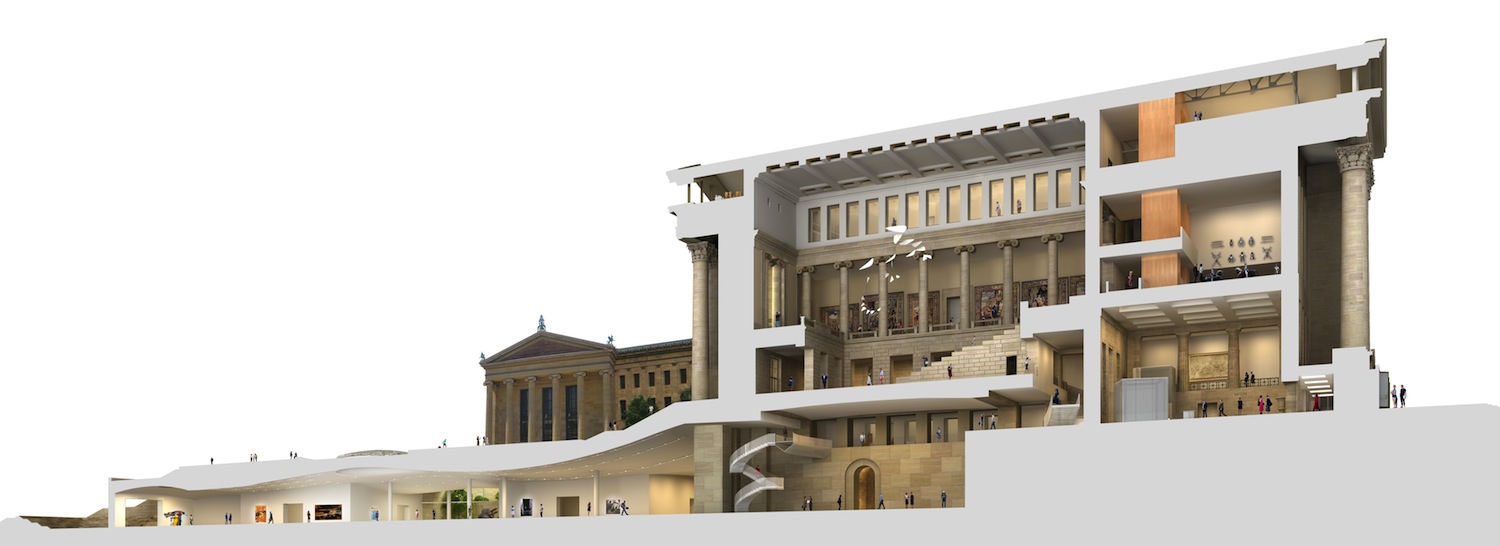
A cross-section view showing the changes to existing interior spaces and the new underground galleries. Rendering: Gehry Partners
Given the prominence of the Museum’s main building as a landmark, minimal changes have been proposed for the exterior by Gehry Partners and OLIN, the noted Philadelphia firm specializing in landscape architecture, planning, and urban design. These changes include:
• The redesign of the plaza in front of the west entrance and the landscaping of a substantial portion of the area now used for parking on this side of the building.
• The integration of skylights and sunken gardens into the east terrace to bring natural light into the new galleries that have been proposed.
• The addition on the northeast and southeast corners of the building of stair enclosures that will be simple in form and clad in the same sandstone used on the exterior in order to be as unobtrusive as possible.
By contrast, many significant changes have been proposed for the interior, yielding an increase of 124,000 sf of public space, including 78,000 sf of gallery space throughout the building. Other changes address access and circulation through the varying “ground” levels of the facility.
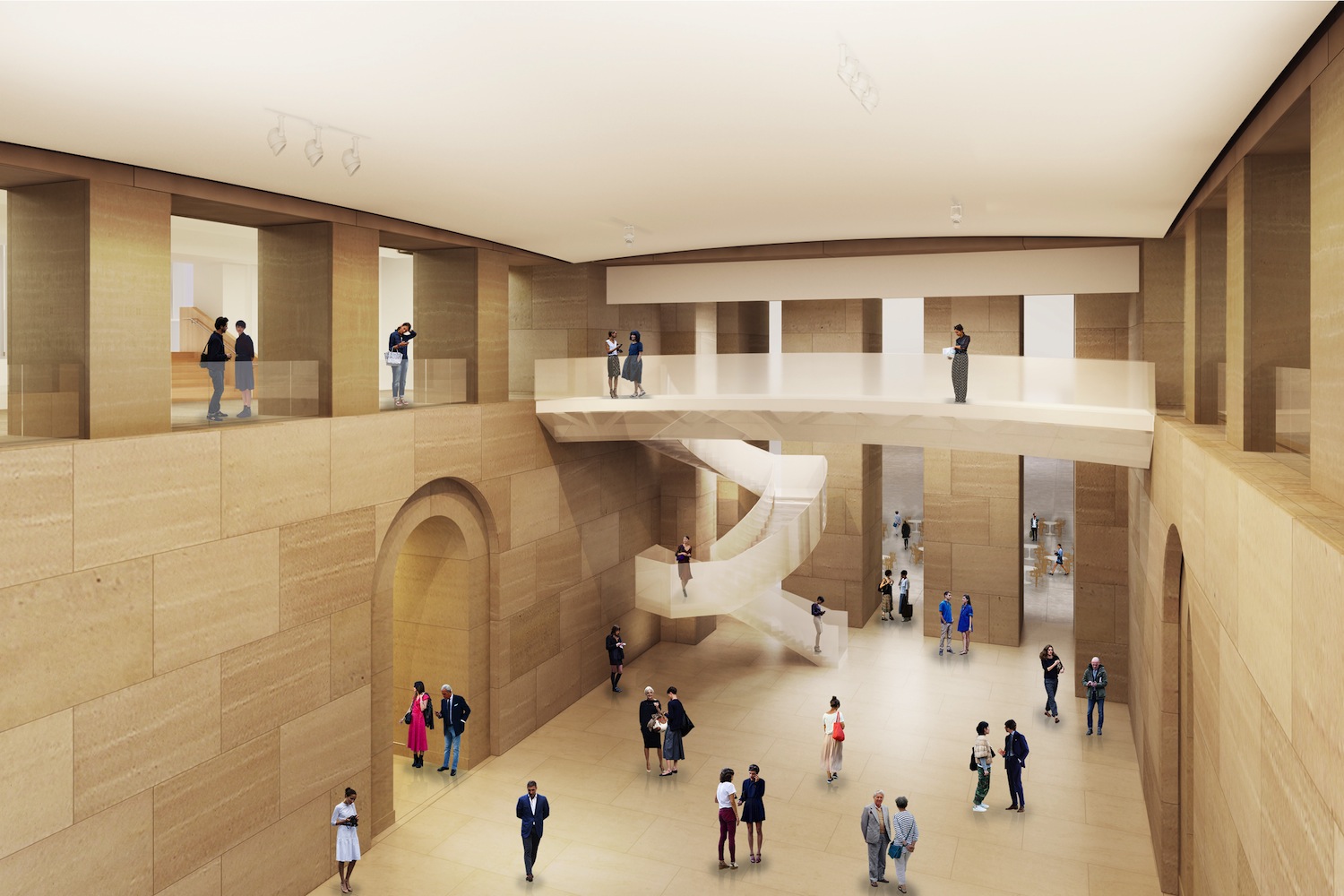
Forum Gallery: The heart of the museum will be opened up, creating a clear sight line through the ground-floor and first-floor galleries that will greatly simplify wayfinding. Rendering: Gehry Partners
At present, visitors enter the museum on the first floor through the east entrance and the Great Stair Hall or on the slightly lower floor through the west entrance and Lenfest Hall. The Gehry design will open new spaces to explore, such as the Forum and new galleries under the East Terrace.
Among the interior changes are:
• The renovation of the two principal public entrance spaces in the museum: Lenfest Hall and the Great Stair Hall.
• The creation of a new public space, or Forum, immediately below the Great Stair Hall in the center of the U-shaped Museum building. The forum will dramatically improve circulation on this floor and open up the east-west axis at the center of the building, enabling visitors to reach the new galleries and adjacent public spaces that Gehry Partners have proposed be built below the East Terrace.
• The relocation of a variety of back-office functions to add nearly 23,000 sf of new gallery space within the existing building; the creation of a new 10,000-sf education center; and the development of new visitor amenities, including a restaurant, café, and spaces for the museum store.
• The creation of 55,000 sf of new space for the presentation of special exhibitions and works from the collection in galleries underneath the east terrace. Ranging in height from 24 to 28 feet, with a vaulted ceiling supported on slender columns, these new galleries will be among the largest and most spacious in the entire Museum. Open in plan and filled with natural light, they will provide an ideal setting for the display of modern and contemporary art.
• The reopening of a public entrance on the north side of the museum. Closed to the public since the 1970s, this monumental arched entrance adjacent to Kelly Drive will be renovated to provide access to a grand vaulted corridor—part of the original design of the building—that runs 640 feet from the north to the south side of the building. This walkway will provide access to the new galleries through a long, vaulted arcade and will intersect with the new Forum directly below the Great Stair Hall, thus providing access to the entire building for visitors entering on this level.
• A new 299-seat auditorium equipped for lectures, performances, and public events, to be located underneath the northwest terrace of the main building and directly accessible from the new public entrance facing Kelly Drive.
• The adaptation of the center portion of the top floor of the U-shaped Museum building to create meeting and event spaces, and the replacement of the brick in the pediments with glass to provide dramatic views of the city and Fairmount Park.
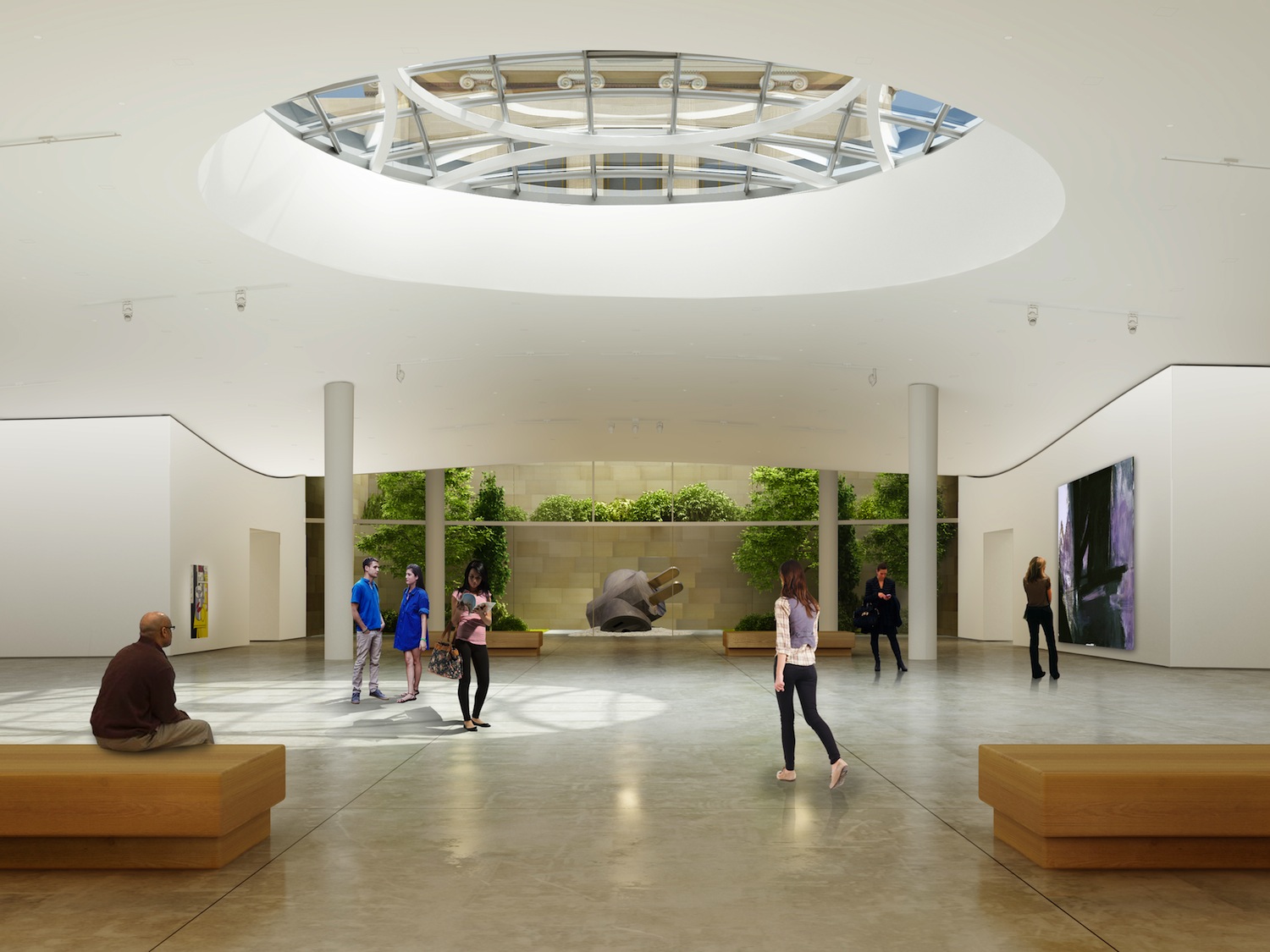
Level C Galleries: The new underground galleries will be lit in part by a skylight in the East Terrace. Rendering: Gehry Partners
“Given the ambitious scope of the plan, it has been designed in separate phases that can be implemented as funds become available," said Gail Harrity, the Museum’s President and COO. "This work must begin with—and be sustained by—an inspiring and persuasive vision of the future, recognizing that it will take years to implement the brilliant plan developed by Frank Gehry and his partners.”
The Building Team includes:
Architects: Gehry Partners, LLP, OLIN
Structural/civil engineer: Magnusson Klemenic Associates
MEP engineer: AltieriSeborWieber
BIM consultant: Gehry Technologies Inc.
Life safety/fire protection: Hughes Associates
Lighting consultant: L’Observatoire
Daylighting consultant: Loisos + Ubbelohde Associates
Theater/AV consultant: Auerbach Pollock Friedlander
Specification writer: CG Associates
Environmental design engineering: Atelier Ten
Waterproofing consultant: Henshell & Buccellato, Consulting Architects
Acoustical engineer: Cerami & Associates
IT/AV consultant: Shen Milsom & Wilke
Security consultant: Ducibella, Venter & Santore
Vertical transportation: Lerch Bates, Inc.
Exterior enclosure: Gordon H. Smith Corporation
Urban design: Urban Strategies Inc/JZTI
Historic preservation architect: Kelly/Maiello Inc.
Cost estimation: AECOM
Site survey: Pennoni Associates Inc.
Geotechnical engineering: Haley & Aldrich
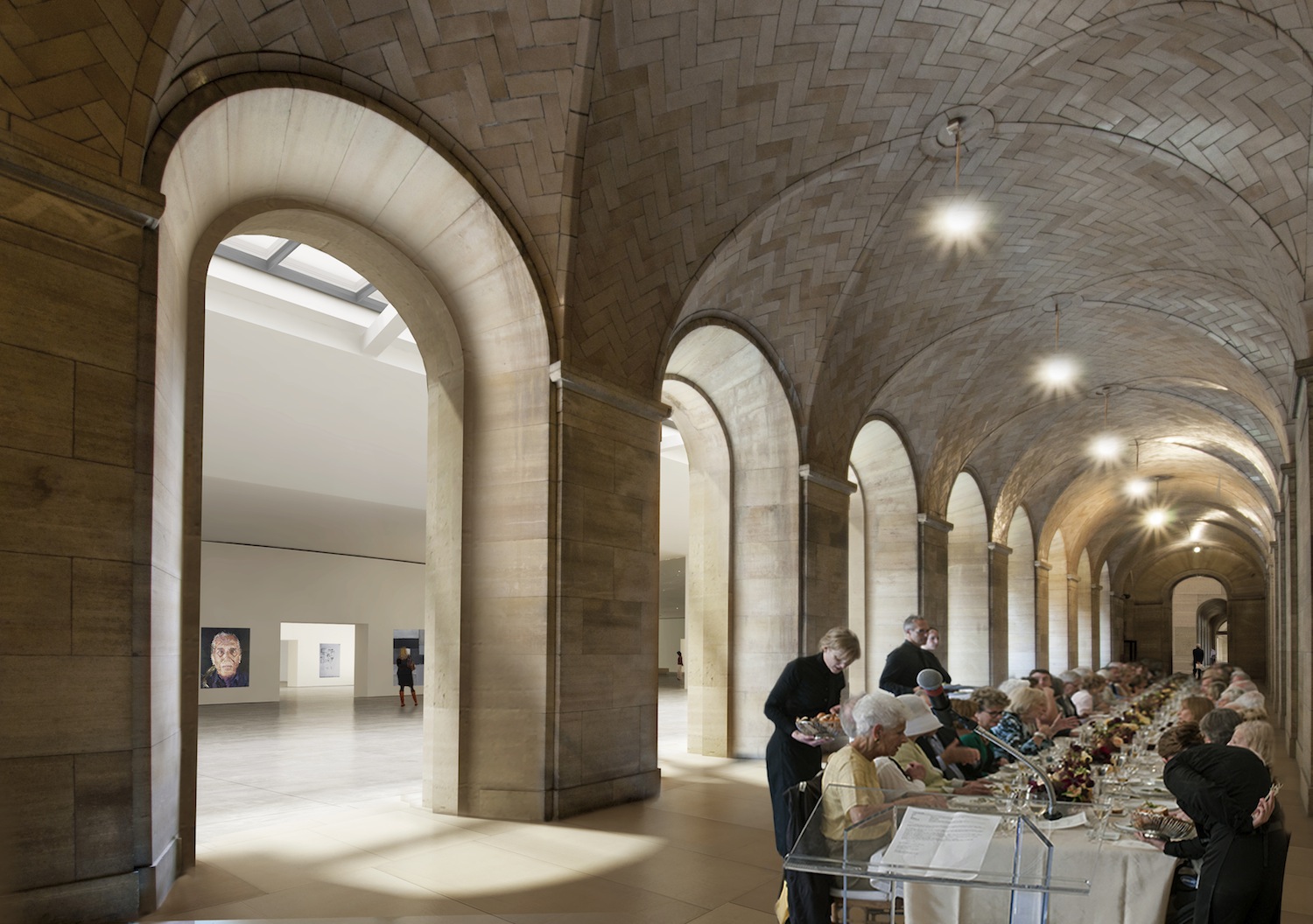
Vaulted Walkway: The vaulted underground walkway, long closed to visitors, will become a space for art and events, with entrances at the north (Kelly Drive) and south (Schuylkill River) sides of the building. Rendering: Gehry Partners
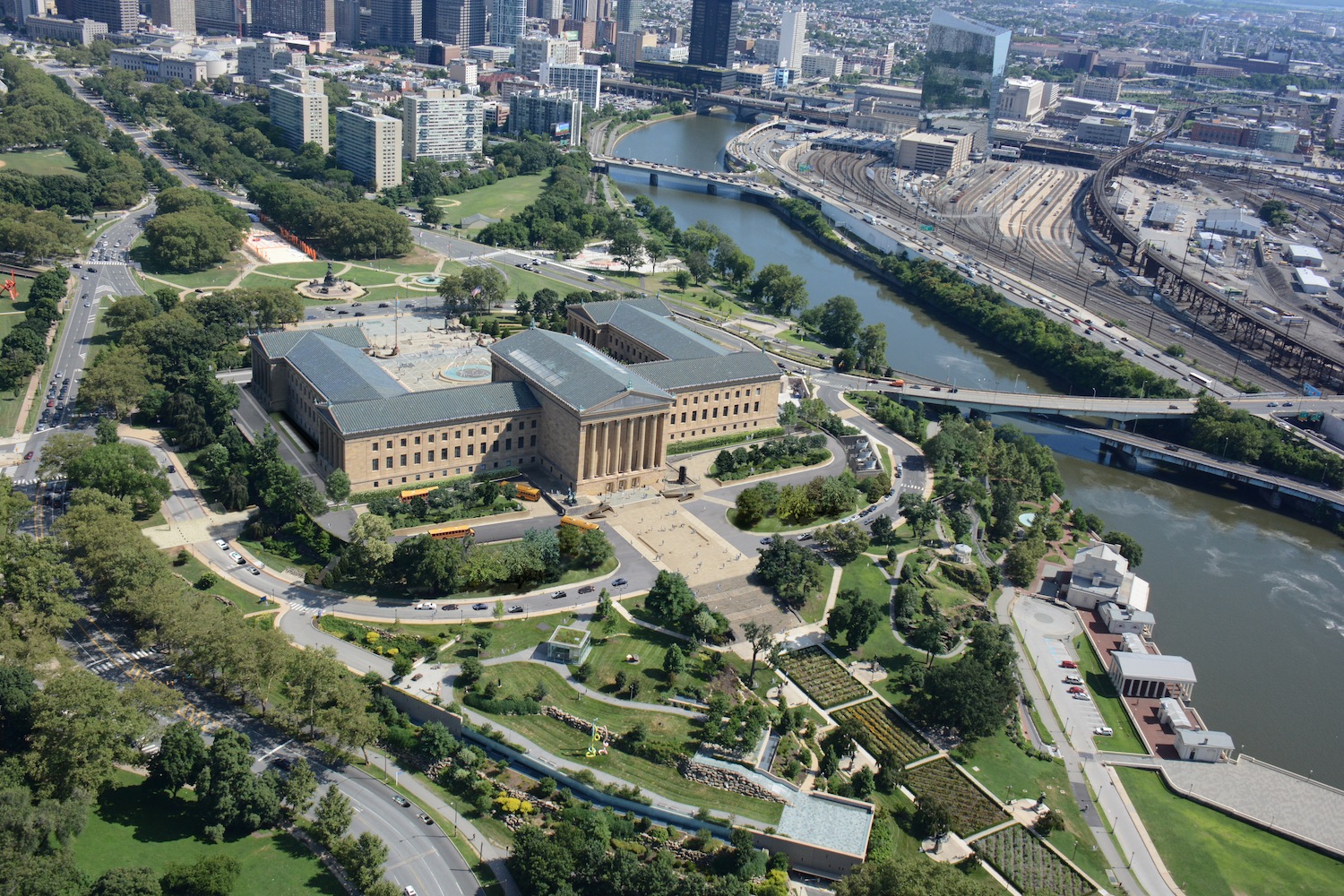
West Terrace. Rendering: Gehry Partners
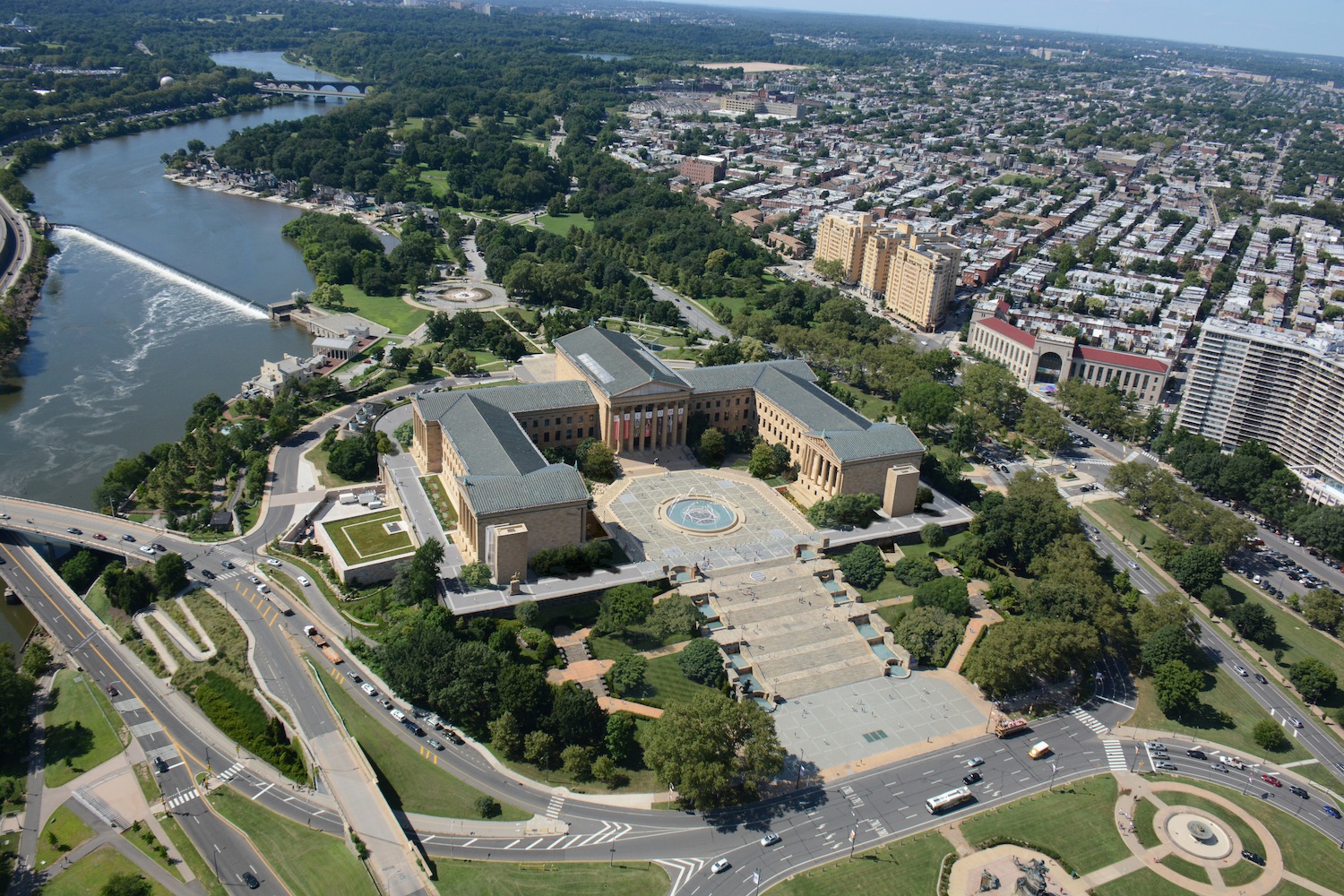
East Terrace with famed "Rocky steps." Rendering: Gehry Partners
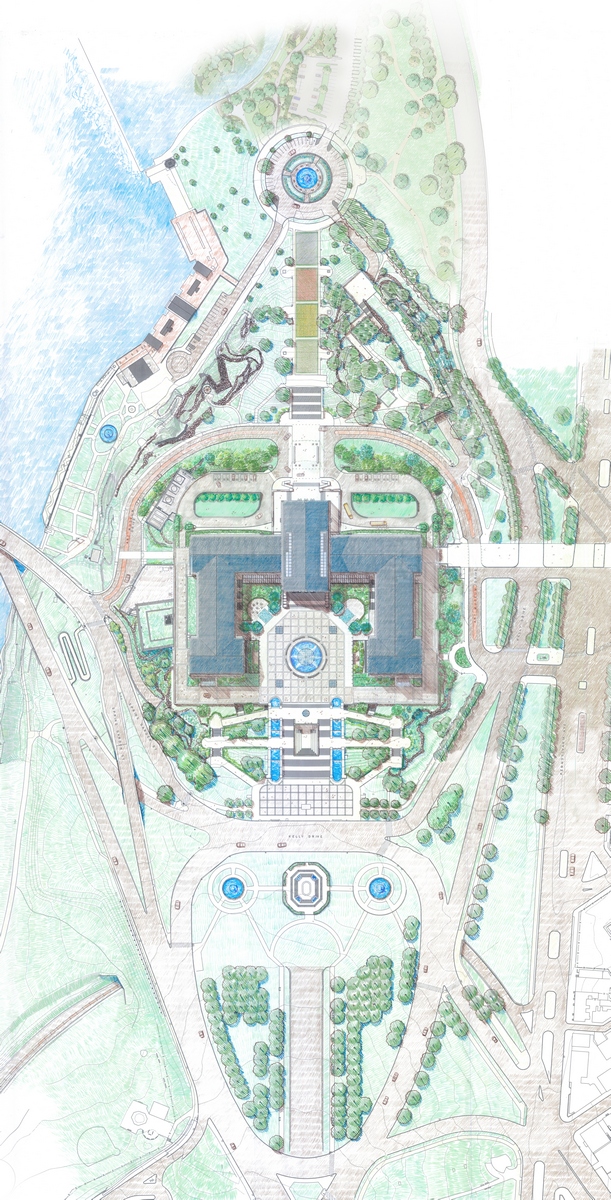
PMA Rendered Plan, OLIN
Related Stories
| Aug 11, 2010
Luxury Hotel required faceted design
Goettsch Partners, Chicago, designed a new five-star, 214-room hotel for the King Abdullah Financial District (KAFD) in Riyadh, Saudi Arabia. The design-build project, with Saudi Oger Ltd. as contractor and Rayadah Investment Co. as developer, has a three-story podium supporting a 17-story glass tower with a nine-story opening that allows light to penetrate the mass of the building.
| Aug 11, 2010
Three Schools checking into L.A.'s Ambassador Hotel site
Pasadena-based Gonzalez Goodale Architects is designing three new schools for Los Angeles Unified School District's Central Wilshire District. The $400 million campus, located on the site of the former Ambassador Hotel, will house a K-5 elementary school, a middle school, a high school, a shared recreation facility (including soccer field, 25-meter swimming pool, two gymnasiums), and a new publ...
| Aug 11, 2010
New Jersey's high-tech landscaping facility
Designed to enhance the use of science and technology in Bergen County Special Services' landscaping programs, the new single-story facility at the technical school's Paramus campus will have 7,950 sf of classroom space, a 1,000-sf greenhouse (able to replicate different environments, such as rainforest, desert, forest, and tundra), and 5,000 sf of outside landscaping and gardening space.
| Aug 11, 2010
U.S. firm designing massive Taiwan project
MulvannyG2 Architecture is designing one of Taipei, Taiwan's largest urban redevelopment projects. The Bellevue, Wash., firm is working with developer The Global Team Group to create Aquapearl, a mixed-use complex that's part of the Taipei government's "Good Looking Taipei 2010" initiative to spur redevelopment of the city's Songjian District.
| Aug 11, 2010
Florida mixed-use complex includes retail, residential
The $325 million Atlantic Plaza II lifestyle center will be built on 8.5 acres in Delray Beach, Fla. Designed by Vander Ploeg & Associates, Boca Raton, the complex will include six buildings ranging from three to five stories and have 182,000 sf of restaurant and retail space. An additional 106,000 sf of Class A office space and a residential component including 197 apartments, townhouses, ...
| Aug 11, 2010
Restoration gives new life to New Formalism icon
The $30 million upgrade, restoration, and expansion of the Mark Taper Forum in Los Angeles was completed by the team of Rios Clementi Hale Studios (architect), Harley Ellis Devereaux (executive architect/MEP), KPFF (structural engineer), and Taisei Construction (GC). Work on the Welton Becket-designed 1967 complex included an overhaul of the auditorium, lighting, and acoustics.
| Aug 11, 2010
Best AEC Firms to Work For
2006 FreemanWhite Hnedak Bobo Group McCarthy Building Companies, Inc. Shawmut Design and Construction Walter P Moore 2007 Anshen+Allen Arup Bovis Lend Lease Cannon Design Jones Lang LaSalle Perkins+Will SmithGroup SSOE, Inc. Timothy Haahs & Associates, Inc. 2008 Gilbane Building Co. HDR KJWW Engineering Consultants Lord, Aeck & Sargent Mark G.
| Aug 11, 2010
High-Performance Workplaces
Building Teams around the world are finding that the workplace is changing radically, leading owners and tenants to reinvent corporate office buildings to compete more effectively on a global scale. The good news is that this means more renovation and reconstruction work at a time when new construction has stalled to a dribble.
| Aug 11, 2010
Great Solutions: Business Management
22. Commercial Properties Repositioned for University USE Tocci Building Companies is finding success in repositioning commercial properties for university use, and it expects the trend to continue. The firm's Capital Cove project in Providence, R.I., for instance, was originally designed by Elkus Manfredi (with design continued by HDS Architects) to be a mixed-use complex with private, market-...
| Aug 11, 2010
Nurturing the Community
The best seat in the house at the new Seahawks Stadium in Seattle isn't on the 50-yard line. It's in the southeast corner, at the very top of the upper bowl. "From there you have a corner-to-corner view of the field and an inspiring grasp of the surrounding city," says Kelly Kerns, project leader with architect/engineer Ellerbe Becket, Kansas City, Mo.








